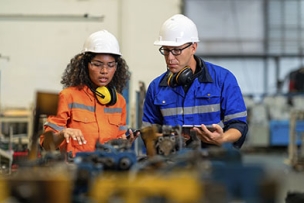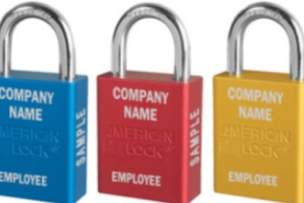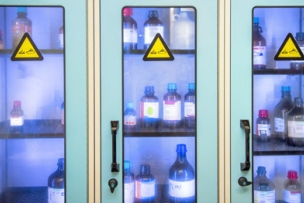Learn how to use the 5S method to help improve your safety program.
Many methods used in lean manufacturing, including 5S, are designed to help companies become more efficient and less wasteful. But they can also be used to help reduce worker and facility safety risks and apply new, smart safety communication strategies.
In machine shops that have implemented lean manufacturing programs, the principles of 5S are well known. They include Sort, Straighten (also known as “Set in Order” or “Stabilize”), Shine (also known as “Scrub” or “Sweep”), Standardize and Sustain.
But where does safety fit in? Some, not convinced that it does fit in as much as it should, believe that a sixth “S” specifically dedicated to safety is needed in lean programs. Others, however, think that proper implementation of 5S yields safety-related benefits that can help keep workers safe and productive.
“When we do 5S, we are redesigning our workplace to fit our needs, and one of those needs is lowering the amount of risk to what we believe is acceptable,” says Peter Susca, principal of OpX Safety, a firm that helps companies improve operational performance by using safety as a gauge of organizational health. “So if you do 5S right, safety should be well integrated into those principles.”
Want to go deeper? Learn how 5S is a cornerstone in lean manufacturing in the article “Quick Start Guide to 5S Methodology.”
What Are the Key Elements of 5S in Lean Manufacturing?
Here’s how Susca believes safety can come into play as shops take steps to implement 5S:
Sort. Hazards might be pieces of equipment—for example, machines that spew cutting fluids and potentially harmful projectiles into the plant environment. “So sorting can be sorting out which hazards you really need and which ones you don’t,” Susca says. “If a machine doesn’t add value, get rid of the machine, don’t put a guard on it.”
Straighten. By straightening out a process, shop personnel can reduce or eliminate unnecessary work by making sure things are done efficiently. In addition, straightening can have safety implications. “The amount of times I lift something is directly proportional to the amount of exposure I have to getting hurt,” Susca notes. “The amount of times I’m in a high-noise area is directly proportional to the impact on my hearing. If I’m doing these things more than I need to, that’s waste and waste can also cause excessive risk.”
Shine. This involves cleaning up an area and making it orderly. Susca advises shops to come up with an idea of what different things in a given area should look like and then develop a discipline for keeping them in that condition.
How can this “S” impact safety? Consider a plexiglass shield on a machine that prevents dangerous objects from flying out of the cutting area. “Say you’re not cleaning the shield and it has gotten so much cutting fluid on it that you can’t see through it. So you swing it out of the way,” Susca says. If the shield is kept clean, however, the operator has no reason to move it, so it stays in place and performs its safety function.
“When we do 5S we are redesigning our workplace to fit our needs, and one of those needs is lowering the amount of risk to what we believe is acceptable. So if you do 5S right, safety should be well integrated into those principles.”
Standardize. To implement this “S,” Susca advises shop personnel to abide by the old maxim: “There is a place for everything and everything in its place.” To find an example of how this can impact safety, look no further than the pallets on the shop floor. “How often do you walk through a manufacturing facility and find pallets encroaching on walk areas?” Susca says. “Then you ask people where the right place for the pallet is, and nobody knows. There are plenty of wrong places—and you find them when people get hurt.”
On the other hand, if there’s an outline on the floor of where the pallet should go, it’s more likely that the pallet will end up there rather than in the middle of an aisle.
“We do a fair amount of stencils, so people can paint on their own floor where pallets and other things go,” says Patrick Madigan, general manager of National Marker Co. (NMC), a maker of signs and other safety communication products.
These visual aids are important in implementing standardization. In some cases, they are also required by standards issued by organizations such as the Occupational Safety and Health Administration and the American National Standards Institute.
See clear examples of OSHA’s rules in our infographic: “OSHA Definitions of Safety Signs.”
OSHA uses colors to show different hazard levels:
- Blue indicates that the hazard level is low. It might be used for an “Employees Only” sign.
- Orange or yellow indicates the presence of a hazard that could probably cause injury but is unlikely to cause death. These colors appear on “Caution” signs.
- Red indicates a hazard that could cause serious injury or death. Red is the color for “Danger” signs.
In addition to signs, NMC makes labels, tags, utility tapes and other safety-related products. While signs indicate the presence of a hazard in the area, labels such as “Danger,” “Do Not Stack” and “Arc Flash & Shock Hazard” might be placed on particular objects that present a hazard.
Sustain. This “S” involves auditing or inspection to make sure that 5S changes and processes continue to be in place and working effectively. To help with this important task, Susca recommends tapping someone from another part of the shop. “I would ask that person how easy is it to figure out things like where a pallet or tool is supposed to be. If somebody from outside that area can tell you, then you’ve got it [right] because that means it’s simple. And the less knowledge you need to sustain, the easier the process is to sustain.”
Do you follow 5S or 6S lean manufacturing principles in your safety practice? How do you handle safety if not it’s own area?





Talk to Us!
Leave a reply
Your email address will not be published. Required fields are marked *